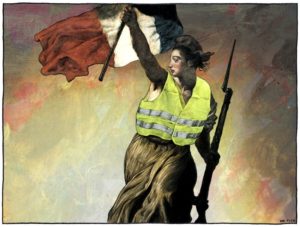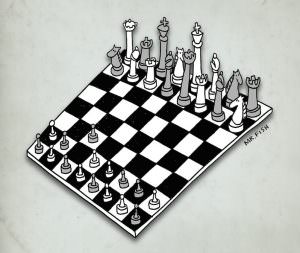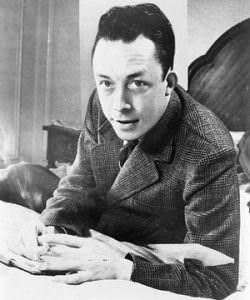Albert Camus: Past and Present
Camus remains the writer who always speaks to individuals, never to groups. He remains perpetually relevant without ever quite being fashionable.A literary anniversary came and went last year with little fanfare, at least in the subject’s own country. Or perhaps it would be more correct to say countries.
Albert Camus was born on Nov. 7, 1913, in Mondovi, Algeria. He never knew his father, Lucien, who was killed in World War I. His mother was of Spanish descent; André Maurois felt “there was a good bit of the Castilian in Camus,” especially the nationally celebrated traits of dignity, nobility in poverty, and defiance in the face of death. As a teenager attending the local lycée — a secondary school that prepared students for university — Camus was forced to drop out when he began coughing blood. There is no knowing how much tuberculosis tempered his outlook on life.
“He wasn’t a boy who was made for all that he tried to do,” Jean-Paul Sartre wrote with uncanny insight. “He should have been a little crook from Algeria, a very funny one, who might have managed to write a few books, but mostly remains a crook. Instead of which, you had the impression that civilization had been stuck on top of him and he did what he could with it.”
That Camus didn’t wind up a professional Algerian street rat, maybe a grimier version of Pépé le Moko, probably had to do with the TB. He was never completely rid of it. Like other famous consumptives, from gambler Doc Holliday to country singer Jimmie Rodgers to fellow author Robert Louis Stevenson, Camus adopted a fatalistic attitude toward life, tinged with sardonic humor. He was intellectually precocious; the disease helped make him emotionally mature.
His most famous novels, “L’Etranger” (once known as “The Stranger” but now, translators assure us, better represented by the title “The Outsider”) and “The Plague,” are set in the now-lost world of French Algeria. Today, Camus is ignored in his homeland, a country that has worked hard to expel its pied-noir (French settler) culture. According to an article in The Guardian last year, “[n]ot a single official commemoration” of Camus’ centenary was held there.
In France, where he lived after the age of 30 and on whose literature he had perhaps the greatest impact of any 20th century writer, no one is sure which side of the political spectrum can lay claim to him. Perhaps this is the fallout of the 2009 controversy in which then-President of France Nicolas Sarkozy wanted to move Camus’ ashes from southern France to the Pantheon in Paris, alongside the remains of Voltaire and Zola. Camus’ son, Jean, accused the right-leaning Sarkozy of trying to “requisition” his father’s legacy. Nothing came of Sarkozy’s plans.
It’s hard to imagine that the reaction of the author of “The Myth of Sisyphus” to all this would have been anything but bemusement. Not that Camus didn’t derive at least some pleasure from his celebrity. In his favorite photograph of himself, taken by no less than Henri Cartier-Bresson, who is considered the founder of photojournalism, he’s wearing a trench coat, said to be a gift from Mrs. Arthur Koestler. He beamed when told he looked like Bogart (though his preferred Bogie was not Rick of “Casablanca” but Philip Marlowe of “The Big Sleep”).
Susan Sontag surely had this photograph in mind when she wrote in 1963 in The New York Review of Books, “The cigarette dangles between the lips, whether he wears a trench-coat, a sweater and open shirt, or a business suit. It is in many ways an almost ideal face: boyish, good-looking, but not too good-looking, lean, rough, the expression both intense and modest. One wants to know this man.”
Since Camus’ death on Jan. 4, 1960, many seem to feel that they do. In Sontag’s words, no modern writer “except Camus, has aroused love.”
Some forms of love, though, are unsettling. In Simone de Beauvoir’s 1954 novel “The Mandarins,” Camus is caricatured with a nastiness generally reserved for former lovers. In 1965, poet Hayden Carruth published “After The Stranger,” a series of dialogues in which he imagines what Camus would have said to him had they ever met. In “Camus, A Romance” (2010), an homage by Elizabeth Hawes, the biographer becomes a literary stalker. Hawes’ only contribution to the field was herself as she attempted to create a portrait of the writer from her personal reactions to his letters and notebooks. Writing with the clarity of a fanatic, she was “both grounded and empowered by the simple fact that I understood what he meant. …” And, “To my way of thinking, Camus would not have existed without me or I without him.” One wishes that her editors had corrected her on this point.
“It strikes me often,” she concluded, “how bizarre it is to spend so much time thinking about someone you can never know.” Reading her book, I thought pretty much the same thing. Camus inspired numerous biographies that take up far more space on library shelves than the novels, plays and essays he published in his lifetime. Yet he remains an enigma. The more popular Camus the writer has grown, the hazier the man has become. His best biographer, Olivier Todd, dispelled the notion that his fiction was largely biographical, writing in “Camus, A Life” (1998) that his “own books do little to bring his personality into focus.” His “carnets” — notebooks — don’t help: “Sometimes I feel that Camus wrote them with posterity looking over his shoulder … rather with the discretion of Johnson explaining himself to Boswell.”
Just about every year brings something new. In 2013, Robert Zaretsky’s compact (181 pages) “Albert Camus: Elements of A Life” broke Camus’ career down into key events, from his experience in occupied France with the underground paper Combat through his split with the Communist Party and subsequent quarrel with Sartre that ended their friendship.
Last year there was “Brave Genius: A Scientist, a Philosopher and Their Daring Adventures From the French Resistance to the Nobel Prize” by Sean B. Carroll, an account of the friendship between Camus and scientist Jacques Monod, beginning with their work together in the French Underground and culminating in their both winning the Nobel Prize in 1957.
That’s Camus’ academic legacy. Equally fascinating is the emergence over the last couple of decades of his presence in popular culture.
Dying like James Dean, not just in a car crash but in a Facel Vega, gave Camus his pop culture niche. No other public intellectual could have inspired a record like The Cure’s “Killing an Arab,” based on the incident around which “L’Etranger” turns, or had a character’s name, Meursault from “L’Etranger,” adopted by a Scottish rock band. On the children’s cartoon show “Madeline,” Meursault, in a prison cell, asks, “Who am I? What am I? Why am I here?” In the Will Ferrell comedy “Talladega Nights,” Sacha Baron Cohen’s Formula One driver whizzes around the track with “L’Etranger” propped open on his steering wheel.
And in 2009, the man who put the word “absurd” into the modern philosophical lexicon reached an undreamed level of absurdity when comic book artist R. Sikoryak published four “Action Camus” covers, parodying “Superman” action comics from the 1950s. The first used the opening line of Camus’ most famous book: “In this issue The Stranger discovered ‘Mother died today,’ to which the Caped Crusader, staring at her headstone with cigarette in hand asked rhetorically, ‘Or was it yesterday?’ ”
For a while, the iconization of Camus, which had begun even before the Nobel Prize, hurt his reputation. Three years after his death, Sontag asked, “Was Camus a thinker of importance?” Her answer was an emphatic “No!” Sartre, she thought, brought “a powerful and original mind to philosophical, psychological and literary analysis. Camus, however attractive his political sympathies, does not.”
Almost as if in answer, Mario Vargas Llosa, one of Camus’ intellectual heirs, wrote in 1975 that rereading Camus after a lapse of many years “was a revelation.” “The Rebel,” his essay on violence in history, “astonished me with its lucidity and contemporary relevance and with the answers that it gave to many doubts and fears that I felt about the reality in my country [Peru].”
Llosa thought Camus “completely rejected totalitarianism as a social system in which the human being is no longer an end and becomes an instrument.” In contrast, Sartre, whom Llosa had preferred in his youth, now seemed to hold “positions on issues [that] were more often wrong than right … that he contributed with more talent than anyone else to the confusion of our times.” (Llosa’s essays can be found in the collection “Making Waves.”) Powerful and original mind or no, Sartre’s work no longer gives off intellectual heat, associated as it is with a Marxist ideology that is mostly recalled with embarrassed silence.
Like George Orwell, a writer he admired but never met — Camus missed a luncheon date with Orwell in Paris after the war — Camus remains the writer who always speaks to individuals, never to groups, and, like Orwell, he remains perpetually relevant without ever quite being fashionable.
Your support matters…Independent journalism is under threat and overshadowed by heavily funded mainstream media.
You can help level the playing field. Become a member.
Your tax-deductible contribution keeps us digging beneath the headlines to give you thought-provoking, investigative reporting and analysis that unearths what's really happening- without compromise.
Give today to support our courageous, independent journalists.




You need to be a supporter to comment.
There are currently no responses to this article.
Be the first to respond.